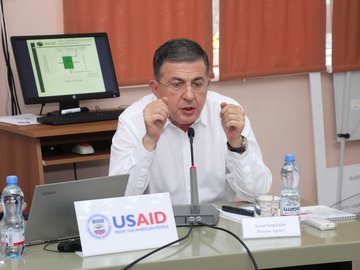On June 20, 2019, Reformeter’s third phase continued with the evaluation of the pension reform and the government research revealed that 82.4% of the reform has been fulfilled. In Phase II, this indicator was at 38.8%
The large portion of the action plan has been implemented and the following activities are still to be carried out:
1. Selecting a custodian bank and a central depositary;
2. Companies that will manage the assets will not be selected and an investment service will be created;
3. Elaborating investment parameters and risk management requirements;
4. Elaborating the mechanism of social pension indexing.
The group of stakeholders evaluated the reform with a score of 5.89 out of maximum 10. This evaluation is higher than the indicator from the previous phase, in which the reform received a score of 4.10.
The discussion was attended by various stakeholders as private sector and non-governmental organizations, the head of the pension agency, Levan Surguladze and the representative of the department of Macroeconomic Analysis and Fiscal Policy Projection of the Ministry of Finance, Mirza Gelashvili. A number of issues have been underlined. More particularly:
• According to the Ministry of Finance, in the reports of international institutions and credit organizations the pension reform is mentioned as a reform that enhances savings, speeds up the Economic Growth and ensures Macroeconomic stability.
• The legislation ponders for the assets mobilized by the pension agency to be placed in a low-risk portfolio for the first 5 years. This means that the operational risk for the above-mentioned portfolio, the credit risk, market risk and all the other risks will cumulatively be added to the value at risk and the overall risk of the portfolio should not exceed corresponding limits. The standard portfolio distribution is the following: a part will be ensured by cash funds and a part by treasury liabilities and the rest by corporate (including Eurobonds) bonds.
• If we look at the dynamics of average salaries, in the first quarter, a rise of 3% has been observed that is the lowest increase since 2015. Based on this, it is necessary to evaluate the influence of the pension reform on salary dynamics.
• We take the replacement rate as an indicator because the pension reform attempts for the retirement to become more painless.
• According to the representative of the Ministry of Economy, developing the capital market is directly related to the pension reform and it cannot be successful without a firm pension system that is also confirmed by the international experience. Without these two components the pension reform is surely to fail.
• Private insurance funds are not developing in the country and the number of companies that offer these services is very low. This happens due to two main reasons: there is only an emergent culture of savings in the country and it was necessary to add the obligatory payment aspect to the reform. Also, the policy related to the tax stimulation was incorrect in regards to this segment. Developing private insurance funds and using the similar approaches used in case of the pension reform is also necessary.







